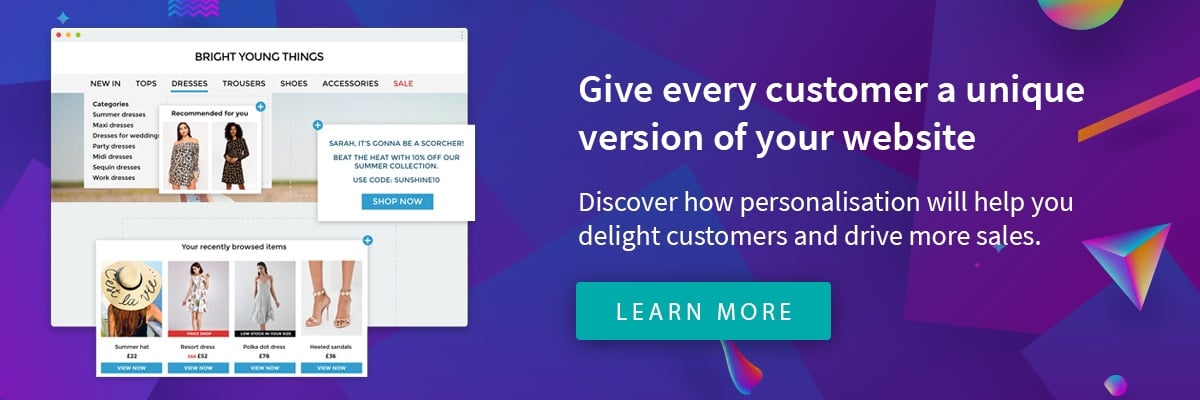Shopping is no longer just about buying.
In 2018, shopping is about giving your customers an experience they’ll never forget. An experience where you immerse the customer in a world of convenience, choices, and easy-to-make decisions—and where your brand is ever-present.
In this blog post, we take a look at the top 2018 retail marketing trends. Read on for predictions of what brands need to do to remain at the top of their game in the next year.
Channel agnostic shopping
Soon shopping channels will cease to exist. Instead consumers will expect a fully integrated brand experience wherever they choose to shop—without an impact on the level and quality of service they receive.
Sadly, most retailers have failed to invest in the technology needed to provide a consistent level of service across their various touchpoints. In a recent survey conducted by Internet Retailing, 53% of retailers admitted that there is a disconnect between the online and the in-store customer experience.
By using customer insight software, retailers can see how customers interact with their brand and integrate the customer experience across the channels.
Solutions like PureIntelligence not only let retailers track their customers’ behaviours both online and offline, but also allow them to pool their data in one place.
This single-customer view means brands can spot trends and opportunities which will help them deliver a seamless experience wherever people are.
Personalised service
In the past year we’ve seen the main players in retail deliver a more personalised and individual experience to customers.
Many now offer the level of service that makes the customer think what they experience has been tailored carefully just for them.
Retailers will increasingly use behavioural targeting tools such as PureTargeting to curate the products displayed on their website and featured in their emails.
This is done around the customer’s interests or purchase history. It creates a more relevant and appealing experience, resulting in higher levels of engagement and conversion.
More retailers, such as supermarkets, will increasingly use the information they gather from all their data points. This may include online purchase history and loyalty card schemes.
They will combine this data using behavioural targeting software to create highly sophisticated replenishment campaigns.
Virtual assistance
From chatbots and voice assistants, to augmented and virtual reality, many retailers are starting to offer customers assistance digitally, both online and in stores.
These handy tools take the pressure off store staff and customer services teams in an age where shoppers demand an immediate response.
So long as quality of service isn’t compromised, it’s a win-win for the retailer who saves money and resource, and for the customer who demands answers immediately.
We think it’s a trend that’s set to continue and expect to see many more examples of digital assistance being introduced into the shopping experience in 2018.
Faster and quicker
The trend for faster and more flexible delivery options will continue in 2018. Thanks to the success of subscription services such as Amazon Prime, consumers’ expectations are higher than ever.
And it makes commercial sense. Research suggests that 67% of shoppers would spend more if a retailer offered same-day delivery. What’s more, over half of shoppers would opt to take their business to a competitor if they offer more convenient delivery options.
We also predict that mobile conversion will continue to increase in 2018, as people will become more willing to not only browse, but buy on the go.
This will be a result of mobile payments becoming ever simpler and safer, as retailers offer slicker methods of transacting including Apple Pay, Square, and Stripe.
Responsive and flexible
Retailers will need to provide a much more responsive and flexible service to cater for the growing needs and whims of fickle customers.
Customer journeys rife with friction points will increasingly turn off shoppers, and negatively affect their perception of brands.
This all means that one-size-fits-all messages and limited customer service options are going to drive away the customer. Customers have now become used to more choice about how they interact.
Smart retailers are responding to this by investing in technology that tracks and reacts to a greater variety of behaviours.
Behavioural targeting technology automatically responds to each individual customer’s actions with responsive email automations. These gently lead them through the sales process.
Takeaway
These are just some of the top 2018 retail marketing trends we expect to see in the year ahead. The strategies and tactics we’ve discussed are how we think smart retailers need to react, to attract—and keep—customers in the forthcoming year.
With the right technology and the ability to integrate your customers’ data, you can easily take advantage of these tactics. This will enable you to create a cutting-edge customer experience which will have them coming back for more.
We’re excited about these new trends and can’t wait to see retailers put them into action in 2018!




